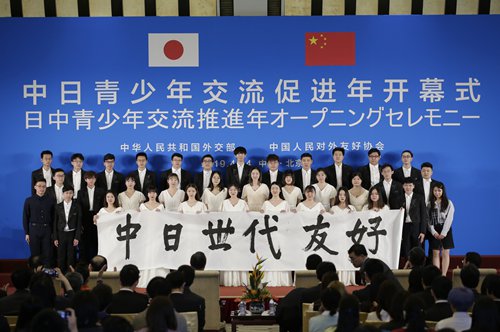HOME >> BUSINESS
China-Japan AEO takes effect, underpinning robust trade growth
Source:Global Times Published: 2019/6/2 19:43:41

Chinese and Japanese youths hold a banner reading "Friendship between China and Japan from generation to generation" at an opening ceremony for the China-Japan year of youth exchange at Diaoyutai State Guesthouse in Beijing on Sunday. Photo: AFP
The authorized economic operator (AEO) system between China and Japan took effect on Saturday, allowing companies from both countries to trade with greater convenience in customs declarations, according to a report by Chongqing Morning Post on Sunday.Experts noted that multilateral deals such as this can provide China with opportunities for growth against the backdrop of the China-US trade war.
The agreement on the AEO system, which was signed in October 2018, said that China and Japan will provide preferential policies to companies recognized as authorized economic operators, according to a statement released by the General Administration of Customs.
The agreement is also seen as the first step of a wider AEO system with other countries and regions, notably those along the Belt and Road Initiative (BRI), including Russia, Malaysia, Iran and the United Arab Emirates, according to the report by Chongqing Morning Post.
In 2018, trade between China and Japan totaled $327.7 billion, increasing 8.1 percent from the previous year. In 2018, 1,752 Chinese companies recognized as AEOs exported to Japan, accounting for 24 percent of China's total exports to Japan, the report said.
Li Daxiao, chief economist at Shenzhen-based Yingda Securities told the Global Times that developing strong and diverse trade relations will help economic growth in China.
"Building strong multilateral trade relations is a forward-looking strategy," Li said. "It buffers the uncertainties such as the trade friction between China and the US, and it helps create a healthier, more balanced international trade environment."
The uncertainties lurking in the trade war between China and the US was shown in the sharp drop of trade volume. In the first four months of 2019, yuan-denominated trade between China and the US decreased 11.2 percent from the same period last year, according to customs data.
However, trade between China and BRI markets has been booming. According to customs data, trade between BRI countries and China jumped 7.8 percent in the first quarter of 2019, reaching 2 trillion yuan ($289.64 billion). Trade with Russia grew 9.8 percent, and trade with Saudi Arabia increased 33.8 percent.
"Multilateral trade has proven to be an important strategy to ensure healthy and balanced growth," Li said. "Diverse trade partners create an international environment that has protected China's trade from pressure by the US."
Posted in: ECONOMY